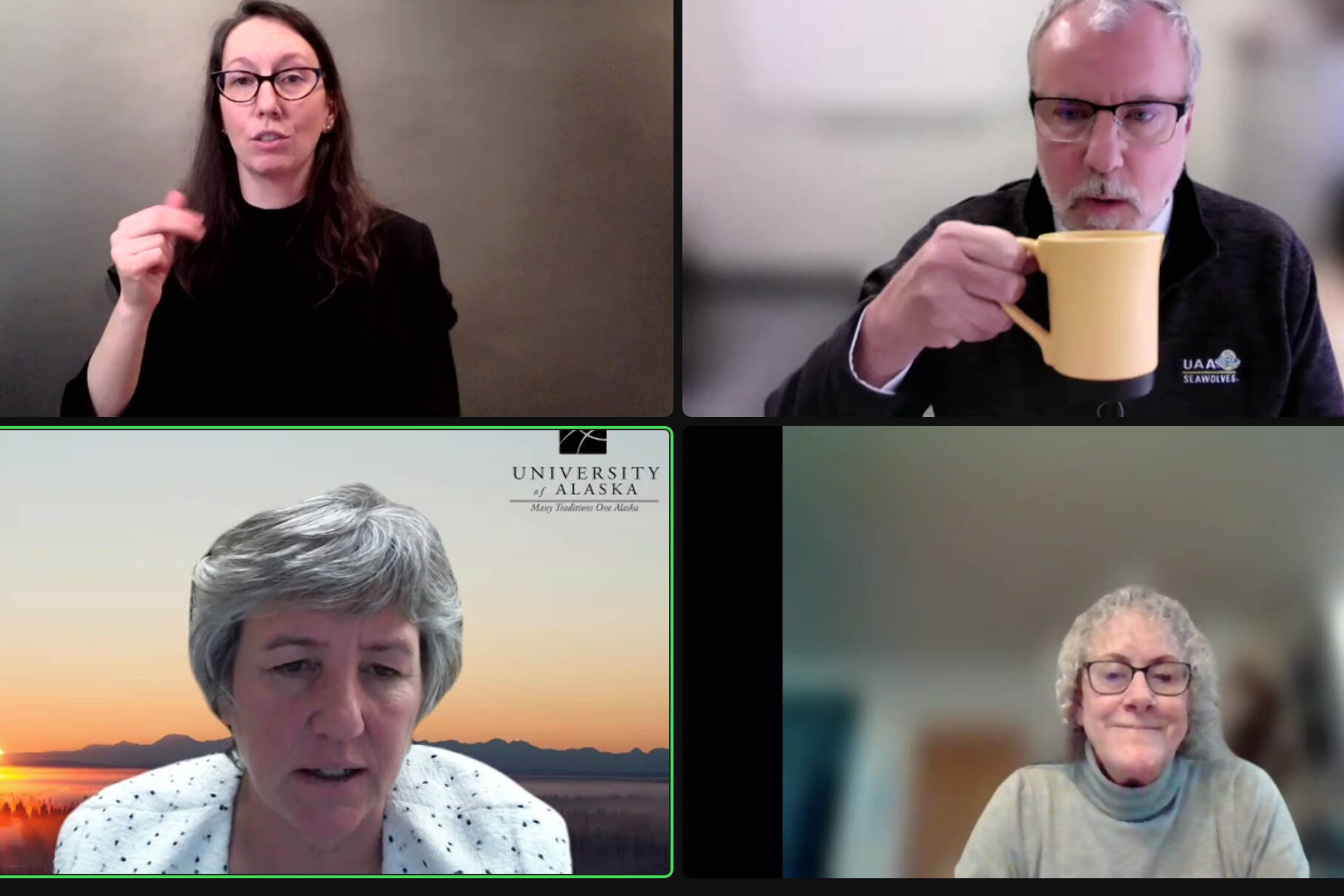University of Alaska Interim President Pat Pitney told students and faculty Thursday there were plenty of reasons to be optimistic about the future of the state’s university system.
“We are starting in a much better place,” Pitney said in a virtual forum. “We are re-creating ourselves. We are smaller, there’s no doubt. That smaller core is what we can build on.”
At the meeting, students were able to ask questions of Pitney and administrators of the three universities. Top of mind for students were COVID-19 mitigation rules, expansion of programs and general stability for the system.
The university system is coming out of a three-year budget reduction of over $70 million enacted by Gov. Mike Dunleavy starting in 2019. That process saw the reduction of a number of courses and programs across the system. At one point consolidation of the three universities into one statewide school was considered. But Pitney said at the meeting she stood behind the system’s three-university model and said the diversity of campuses was one of UA’s strengths.
“The consolidation can come on the administration side like human resources, etc,” Pitney said. “The mission and outward-facing programs are university-based. I’m invested in doing everything we can to make those programs as strong as possible.”
Through an action of the UA Board of Regents and the governor’s proposed budget, the university is expecting to see a modest increase in funding this year. Part of that increase will be used for a slight pay increase for employees, Pitney said, noting the increase was only the second time in recent years there had been an increase.
“Our ability to provide high-quality services depends on retaining our employees,” Pitney said.
[Lawmakers welcome tone change in governor’s address]
Dunleavy has signaled greater support for the university system, saying in his State of the State address on Tuesday the system was central to his vision of Alaska’s future. But Pitney said the system was still hurting from reductions, and that would likely remain the case for sometime.
However, the UA students, backed by the university, are currently in litigation against the administration for the decision in 2019 to make the Higher Education Investment Fund included in funds annually moved to a reserve account. Pitney mentioned the suit briefly on Thursday, saying the university was also involved in parallel work at the legislative level in case the suit is lost.
In response to a question about COVID-19 mitigation rules and when they might end, Pitney and school administrators said they are examining policies on a case-by-case basis. There are vaccine requirements for certain populations Pitney said, such as at the UAF campus due to federal contracts that school holds and for students living on campus.
There are also vaccine requirements for certain classes that require close contact or where social distancing can’t be implemented, Pitney said. Masking is still required on campuses, Pitney said, but officials are looking at when that might end. UAF Chancellor Daniel White said that school has a task force looking at areas and events where students might be able to meet without masks.
“I can assure that planning is underway and we are looking forward to that day,” White said.
UA Southeast Chancellor Karen Carey said there was not a vaccination requirement across campus, but certain classes and students living in dorms were required to be vaccinated.
“We are being very careful. We feel fortunate with where we are at the outbreak in the Southeast,” Carey said. “We are talking about coming out of this phase. We are not there yet. We are making plans for moving forward.”
In support of the system’s Alaska Native Success Initiative, Pitney said the university was recently able to hire a staff member to help coordinate efforts to make UA more accessible to Alaska Native students.
Senior adviser for Alaska Native success Pearl Bower said at the meeting hers was a new position meant to build on past work for inclusion for Native students.
“I think what’s important with Alaska Native Success Initiative is it is good for everyone, it’s good for Alaska,” Bower said. “We will be thinking about how we train, engage the Alaskan community in our work. There is a lot of work to be done, but we look forward to connecting.”
Carey said she recently put together a team at UAS to look at inclusion for several groups including people with disabilities, LGBTQ people, minority groups and Alaska Natives.
“We are going to be hiring a mentor-adviser for Alaska Native students,” Carey said. “We have some retention issues there. We want to make sure that students feel welcomed.”
Pitney said in conversations with Alaska’s business community UA graduates were in demand because of their likelihood for remaining in the state. Support for the university from Alaska residents was evident by the record donations the system received in last year’s fundraising drives, with $275 million being raised systemwide.
A priority going forward is modernization of the university’s Information Technology system, Pitney said, which will help the school interact with students. Pitney said the governor has supported that effort in his proposed budget.
“We are the state’s provider of today and tomorrow’s workforce,” Pitney said. “We have seen great success in our efforts for preparing Alaskans for the workforce. UA graduates stay and add to the community.”
Contact reporter Peter Segall at psegall@juneauempire.com. Follow him on Twitter at @SegallJnuEmpire.

